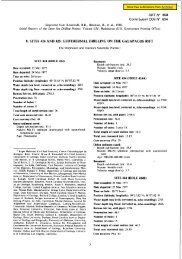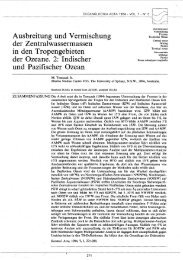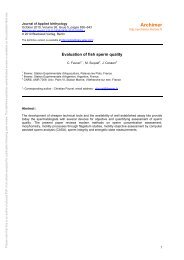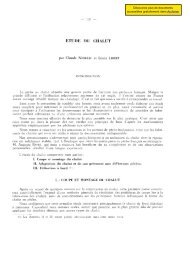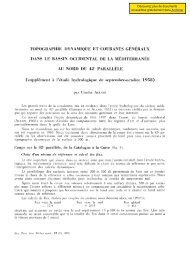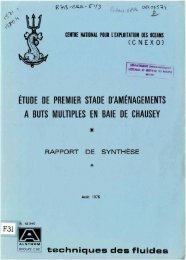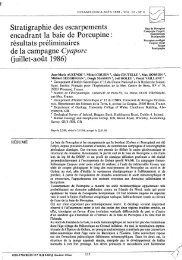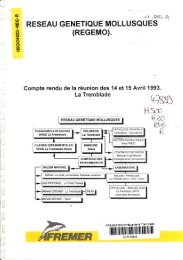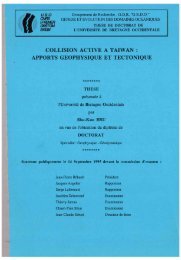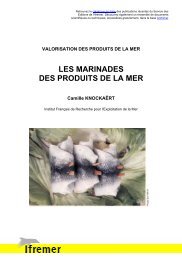- Page 1 and 2:
1 1 1 1 Année 1995 UNIVERSITE DE B
- Page 3 and 4:
à mes parents à Stéphane
- Page 5 and 6:
1 1 ) TABLE DES MATIERES INTRODUCTI
- Page 7 and 8:
3 - Essais d'infection expérimenta
- Page 9 and 10:
INTRODUCTION
- Page 11 and 12:
d'approche pour contrôler les mala
- Page 13 and 14:
1 1 1 1 1 1 1 1 j Un premier chapit
- Page 15 and 16:
DONNEES BIBLIOGRAPHIQUES 1 - Rappel
- Page 17 and 18:
1 1 1 1 1 1 1 1 1 1 1 1 1 1 1 1 1 1
- Page 19 and 20:
et Wray, 1952 ; Mackin, 1962 ; Burr
- Page 21 and 22:
1 1 1 1 1 1 1 1 des zones indemnes
- Page 23 and 24:
3 - Procaryotes Les mollusques biva
- Page 25 and 26:
Tableau 4 : Infections à Chlamydie
- Page 27 and 28:
cheptels de C. angulala, a conduit
- Page 29 and 30:
t t 1 1 1 1 t 1 1 t 1 1 t 1 1 t 1 1
- Page 31 and 32:
i 1 1 1 1 1 1 1 1 1 1 1 1 1 J 1 int
- Page 33 and 34:
1 1 1 1 1 1 1 ! 1 1 1 1 ! 1 1 1 1 1
- Page 35 and 36:
III - Caractéristiques principales
- Page 38:
1 1 1 1 1 1 1 1 1 1 1 J 3.2 - Entr
- Page 41 and 42:
1 1 1 1 1 1 1 1 1 1 1 1 1 1 1 1 1 1
- Page 43 and 44:
i 1 1 1 1 1 1 1 1 1 1 1 1 1 J 1 int
- Page 45 and 46:
1 1 1 1 1 1 1 1 1 1 1 PREAMBULE Pub
- Page 47 and 48:
Chapitre 1 : Caractérisation d'un
- Page 49 and 50:
l 1 1 1 1 1 1 1 1 1 1 1 1 PUBLICATI
- Page 52 and 53:
References AllIle . w .. SchlOl fc
- Page 55 and 56:
Platichtys flesus, plie, Pleuronect
- Page 57:
Figure 1 : Marquage de coupes de do
- Page 60 and 61:
CHAPITRE 2 Comparaison antigénique
- Page 62 and 63:
Ces électrophorèses ont égalemen
- Page 64 and 65:
1\6 , HMW LMW Figure 1 : Caractéri
- Page 66 and 67:
a 2 3 4 5 6 7 8 9 10 --- - - - - Il
- Page 68 and 69:
Tableau 2 : Comparaison anti géniq
- Page 70 and 71:
Figure 4 : Coupe histologique d'hû
- Page 72 and 73: Chapitre 1 : Mise en évidence et d
- Page 74 and 75: Les virions observés chez les larv
- Page 76: • •• Figure 2 : Cliché en mi
- Page 81 and 82: 2 - Participation à la mise en év
- Page 83 and 84: Figure 10 : Lésions histologiques
- Page 85: Bu ll. Eur. Ass. Fi sh Palhal.. 14(
- Page 89: 736 Material and methods Samples of
- Page 93 and 94: 740 RENAULT (T.) ET COLLABORATEURS
- Page 95 and 96: 742 15. - MURP HY (F.A.) and K INGS
- Page 97: Chapitre Il : Essais de reproductio
- Page 103 and 104: 2 - Essais d'infection expérimenta
- Page 107 and 108: CHAPITRE 3 Effet de la température
- Page 109 and 110: 26°C), de détecter la présence d
- Page 111 and 112: présentent des lésions histologiq
- Page 113: Introduction The Pacific oyster, 'C
- Page 117 and 118: (Table 1). 100% mortality in this g
- Page 119 and 120: than at high temperature (25-26°C)
- Page 121: Our plans for testing this la st hy
- Page 129 and 130: CHAPITRE IV : Essais de propagation
- Page 132 and 133: Figure 1 : Principales caractérist
- Page 135 and 136: 2 - Essais d'infection de primocult
- Page 137 and 138: (SVF) et/ou d'hémolymphe de Crassa
- Page 139: 68 0.2 g/I, KCI, No. P 1300' 2.77 g
- Page 143 and 144: 72 2. Cousserans F, Bonami lR, Comp
- Page 145 and 146: 2.2. Essais d'infection de primocul
- Page 147 and 148: Chapitre V : Mise au point d'un pro
- Page 149 and 150: Du fait de la présence d'une coqui
- Page 151: • " (1 - " 100nm 100nm Figures 1
- Page 154 and 155: Chapitre VI : Mise au point de mét
- Page 156 and 157: chromatine est rejetée en périph
- Page 159 and 160: 528 RM Le DeuN et al ,GD Fig 2. Imm
- Page 161 and 162: 1.2 - Recherche de séquences conse
- Page 163 and 164: DJBE16 DJBE2L DJBECI DJBE16 DJBE2L
- Page 165 and 166: 1.2.2 - Alignement des séquences D
- Page 167 and 168: viral, des spots d'intensité plus
- Page 169 and 170: visualisées sur les dépôts d'ADN
- Page 172:
Figure 6 : Diagnostic de l'infectio
- Page 175 and 176:
CONCLUSION L'ensemble de ce travail
- Page 177 and 178:
séquences disponibles dans les ban
- Page 179 and 180:
REFERENCES BIBLIOGRAPHIQUES Ahne W.
- Page 181 and 182:
Cahour A., 1979. Mar/eilia refringe
- Page 183 and 184:
Darlington R.W. et Moss L.H., 1969.
- Page 185 and 186:
Girard M. et Hirth L., 1989b. Méth
- Page 187 and 188:
Johnson D.C. et Spear P.G., 1982. M
- Page 189 and 190:
Lemaster S. et Roizman B., 1980. He
- Page 191 and 192:
Ohba M., Kanda K. et Aizawa K., 199
- Page 193 and 194:
Read G.S. et Frenkel N., 1978. Herp
- Page 195:
Shuster C.L. et Hillman T.E., 1963.
- Page 200 and 201:
1994 : P. Maffart, R.M. Le Deuff, T
- Page 203:
days, according to Reed and Muench'
- Page 206 and 207:
detect a single infected cell in a
- Page 211 and 212:
Vet Res (1995) 26. 539·543 © Else
- Page 216 and 217:
Annexe 2 : Méthodes et techniques
- Page 218 and 219:
minutes, puis les coupes sont réhy
- Page 220 and 221:
2.1 - Préparation des solutions -
- Page 223:
2.6 - Coloration négative Lors des
- Page 226:
Gel de concentration 4% H 20 Tampon
- Page 229 and 230:
le tampon de transfert et superpos
- Page 231:
NaCI NaN) Ajuster le pH à 7 Tampon
- Page 235:
Epuisement des anticorps 1 - Utilis
- Page 238 and 239:
6 - Prélever la phase supérieure
- Page 241:
Tris-HCl pH8 1 ml Préparer extempo
- Page 245:
2 - Prélever 1 ml de tampon d'hybr



